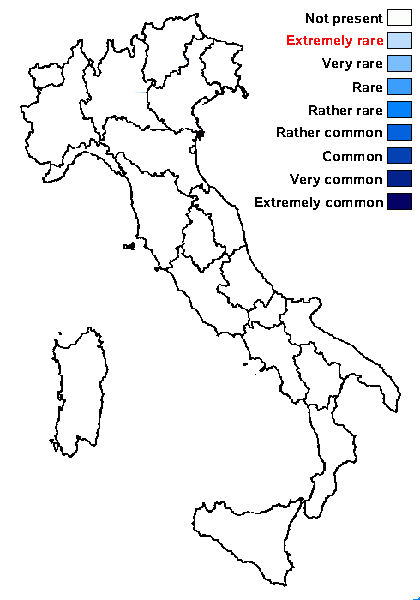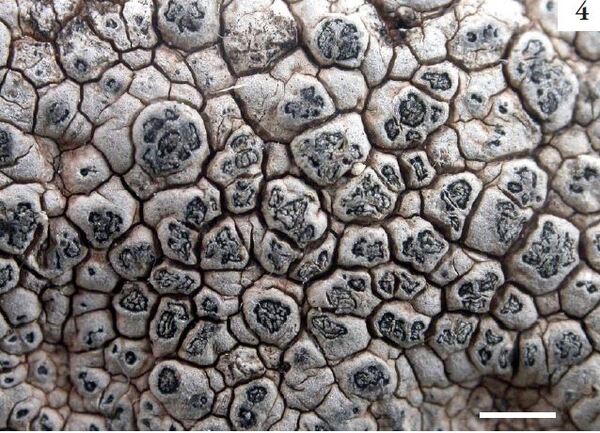Aspicilia bauvetiae Cl. Roux, M. Bertrand & Poumarat
in Roux & coll., Cat. lichens et champignons lichénicoles de France métropolitaine, 3rd ed.: 1261, 2020.
Synonyms:
Distribution:
Description: Thallus crustose, episubstratic, areolate, 0.35-0.8 mm thick, whitish grey, often with a bluish or brownish hue, forming well-delimited, 3-20 cm wide patches delimited by a dark prothalline line. Areoles more or less angular, flat to slightly convex, 0.2-1.9 x 0.2-1.6 mm, the peripheral ones usually elongate and radially arranged. Epinecral layer 5-20 μm thick; cortex paraplectenchymatous, 20-40 μm thick, the upper part not pigmented; algal layer 60-90 μm thick, interrupted by columns of hyphae which are rich in crystals; medulla 250-650 μm high, filled with small, clustered crystals of calcium oxalates, I-. Apothecia lecanorine-aspicilioid, more or less round, 0.15-1 mm across, immersed in the areoles, 1-3(-5) per areole, with a slightly concave to flat, black, epruinose, often umbonate disc, and a poorly visible (often absent), very thin thalline margin. Epithecium brownish green, (7-)10-15(-20) μm thick, N+ emerald green, K+ yellowish brown (Caesiocinerea-green pigment); hymenium colourless, 90-150 μm high, I+ blue turning reddish brown; paraphyses sparingly branched and anastomosing, 2-2.5 μm thick at base, submoniliform in upper part, the apical cells 3-7 μm wide; subhymenium 20-40 μm thick, I+ blue turning greenish; hypothecium absent. Asci 8-spored, broadly clavate, the thin outer coat K/I+ blue, the wall and apical dome K/I-, with biseriately arranged spores. Ascospores 1-celled, hyaline, ellipsoid, (15-)18-24(-27.5) x (8.5-)10-14(-14.5) μm. Pycnidia immersed in the thallus, lageniform to oblong (much higher than wide), the periostiolar area brownish green, the wall colourless. Conidia thread-like, strongly curved to sigmoid, (18-)20-27(-29.5) x 1-1.5 μm. Photobiont chlorococcoid. Spot tests: cortex K-, C-, KC-, P-; medulla K+ bright yellow, C-, KC-, P-. Chemistry; medulla with stictic acid (major).Note: a recently-described species known from France (Southern Alps, Pyrenees), but probably more widespread, growing on horizontal or weakly inclined surfaces of base-rich siliceous rocks, with optimum near or above treeline. To be looked for in Italy,
Growth form: Crustose
Substrata: rocks
Photobiont: green algae other than Trentepohlia
Reproductive strategy: mainly sexual

Predictive model
Growth form: Crustose
Substrata: rocks
Photobiont: green algae other than Trentepohlia
Reproductive strategy: mainly sexual

Predictive model
 INDEX FUNGORUM
INDEX FUNGORUM
 GBIF
GBIF


